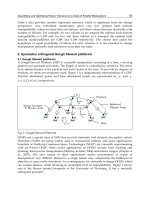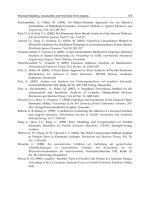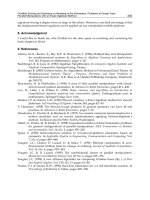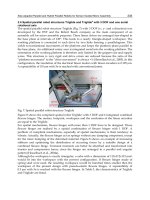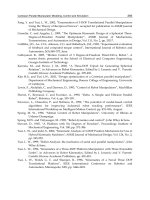InTech-Climbing and walking robots towards new applications Part 16 docx
Bạn đang xem bản rút gọn của tài liệu. Xem và tải ngay bản đầy đủ của tài liệu tại đây (279.54 KB, 8 trang )
Worm-like Locomotion System (WLLS) – Theory, Control and Prototypes
449
where
()
3
2 Ldda
w
−−= ,
()
2
3 Lddb
w
−= . For this assumption and for parameters as
above the length of the segment is equal to
mm5.12 , 4=
s
k and the analytical estimation of
the body velocity is
-1
smm43.1 nv ⋅= .
Body Form is a Broken Line
Let us assume that the form of the body segment between two coils is a straight line. The
equation of the central line of the segment is as follows:
()
Lxddy
wR
−= .
(35)
In this case for parameters as above the length of the segment is
mm2.12 , 4=
s
k and the
analytical estimation of the body velocity is
-1
smm26.1 nv ⋅= . From Fig. 19 we can see that
for
1
100
−
< sn the theoretical result (the body form is determined by the model of an elastic
beam) matches with the experimental data for the sample 1 for the first experiment. The
maximal obtained body velocity is
-1
scm89.7=v for
1
100
−
= sn . For
1
950
−
> sn in the first
experiment sample 1 does not move.
From the second experiment it follows that the segment form of the capsule is a straight line.
The length of the segment is determined by the formula
()
mm66.11
22
=−+=
cs
ddLl ,
6=
s
k
.
(36)
From (20) we find dependency of the velocity of the body on
n
-1
smm1.1 nv ⋅= . The theo-
retical dependency of the velocity of the body
v
on
n
and experimental data are shown in
Fig. 20.
Fig. 20. Body velocity
)(nvv =
(a capsule with a magnetic fluid)
Climbing and Walking Robots, Towards New Applications
450
For the frequency
1
50
−
< sn
the theoretical estimation of the velocity of the capsule matches
with the experiments. In our experiment for
1
700
−
> sn the capsule does not move. The
maximal obtained capsule velocity is
-1
scm56.5=v for
1
50
−
= sn . The body velocity de-
pends on the geometrical shape of the deformed body and that of the channel. Only if
n is
small enough the body inertia does not affect the body velocity and the formula (32) is valid.
A simulation of the dynamic behavior of the elastic body was made by Finite-Element-
Method (Fig. 21). For zn H100< the numerical results coincide with experimental data.
Fig. 21. Analysis of the locomotion (sample 1) for zn H100< using Finite-Element- Method
The Finite-Element-Method is also a useful tool to define optimal control frequencies for the
cascaded system of the coils (switching frequencies). As it is shown in Fig. 22 there exists a
correlation between the measured velocity of the worm, the switching frequencies of the
coils and the eigenfrequencies of the worm respectively.
Fig. 22.The velocity of the worm vs. eigenfrequencies (switching frequencies of the coils)
Worm-like Locomotion System (WLLS) – Theory, Control and Prototypes
451
Finally, we should remark that the type of locomotion realized with the magnetic elastomer
or the elastic capsule filled with ferrofluid is a snake-like motion called concertina motion.
3.5 Design of Active and Passive Locomotion Systems and the Interaction between a
Controlled Magnetic Field and a Magnetic Fluid
A moving magnetic field can generate a travelling wave on the surface of magnetic fluids.
This travelling wave can be useful as a drive for locomotion systems. Therefore, peristalti-
cally moving active locomotion systems could be realized with an integrated electromag-
netic drive (see Fig. 23, left (A)). Also passive locomotion systems can be taken into account.
Objects, which are on the surface of the fluid or are lying in the fluid, could be carried float-
ing and/or shifting (see Fig. 23, left (B) and Fig. 26, 27).
Fig. 23. Schema of possible locomotion systems (left), and the experimental setup (right)
The following properties are important for the locomotion: (i) mass and geometry of the
moving or moved object, (ii) the change of the shape and the position of the magnetic fluid,
and (iii) the pressure distribution of the magnetic fluid with respect to the action of the mov-
ing magnetic field.
To analyse the behavior of the magnetic fluids (under the described action of the magnetic
field) and such locomotion systems, the experimental setup consists of 20 consecutively
arranged cascaded electromagnets (1 coil generates 3000 ampere turns).
The measurement system to detect the pressure of the fluid and the optical system to ana-
lyse the shape of the fluid are connected to a 3 axis-positioning unit (see Fig. 23, right). Fig.
24 shows a travelling wave in a magnetic fluid.
Fig. 24. Travelling wave generated by a moving magnetic field
Climbing and Walking Robots, Towards New Applications
452
Fig. 25 shows schematically the magnetic field, which emerges from an electromagnet, the
shape of the fluid and the pressure distribution.
Fig. 25. Schematical presentation of the electric induction density of an excited coil (left top),
the emerged shape of the magnetic fluid surface (left bottom), and the pressure dis-
tribution of the magnetic fluid (right)
Fig. 26. Example of a passive locomotion by means of travelling waves in a magnetic fluid
Fig. 27. Functional principal of a passive locomotion system (form of the magnetic field (l.)
and the corresponding video sequences (r.))
Worm-like Locomotion System (WLLS) – Theory, Control and Prototypes
453
In the experimental setup using a water–based ferrofluid a maximal change of the fluid
pressure about 2200 MPa was measured in the origin (see Fig. 25, right) after applying the
magnetic field. Thus, it could be a realistic scenario to construct a cascaded structure of
cylindrical membranes filled with a magnetic fluid (“worm”) and to get the necessary inter-
action between “worm” and the environment for peristaltic locomotion.
3.6 Conclusional Remarks
The expression for the magnetic field strength creating a sinusoidal wave on the surface of a
viscous magnetic fluid as a function of the characteristics of the fluid (viscosity, surface
tension, and magnetic permeability) and the parameters of the wave are obtained.
It is experimentally shown that in a specially structured periodic travelling magnetic field a
cylindrical magnetizable elastic body moves along the channel. The direction of the body
motion is opposite to the direction of the travelling magnetic field.
The maximal obtained body velocity is
-1
scm10=v for
1
250
−
= sn . For the frequency
1
100
−
< sn (samples 1) and for
1
50
−
< sn (the capsule with the magnetic fluid) the theoreti-
cal (analytical and numerical) estimations of the velocity of the elastic body (the capsule
with the magnetic fluid) coincide with the experimental data.
The creation of active biologically inspired locomotion systems and new principle for a
passive motion is possible using the deformation deformable magnetizable media in con-
trolled magnetic fields.
4. Summary and Outlook
At the beginning of the chapter it was mentioned that the motion of an earthworm was the
inspiration for a technical solution of an artificial worm. A theory is developed for the peri-
staltic motion of such systems, which to a large extent allows to characterize these motions
already on a kinematic level. The advantage of adaptive control for the dynamical realiza-
tion of these motions is shown. Experiments using a simple prototype checked the results of
the theory.
Using magnetizable materials in compliant structures rather snake-like motion (concertina
movement) has been realized until now. Since the peristaltic crawling of the earthworm has
many advantages for the locomotion in difficult environments the realization of such a mo-
tion remains a challenge in theory and control as well as in experiments (Fig. 28).
Fig. 28. From the snake-like concertina motion to worm-like peristaltic crawling
This also applies to the technological realization of an enveloping membrane structure for
the artificial worm.
Climbing and Walking Robots, Towards New Applications
454
Here two problems (and actually opposite demands) are to be solved:
W membrane thickness as small as possible, to achieve a big force extraction and a very
flexible worm structure and
W membrane thickness as big as possible, to avoid diffusion processes of the ferrofluid
through the membrane and to keep environmental influences away from the ferrofluid
to improve the long-term stability of the worm system.
The objective is to find optimal parameters and to verify these experimentally.
Another challenge for future research is to realize two-dimensional (planar) motions using
ferrofluids.
5. References
Abaza, K. (2006). Ein Beitrag zur Anwendung der Theorie undulatorischer Lokomotion auf
mobile Roboter – Evaluierung theoretischer Ergebnisse an Prototypen, PhD thesis,
Faculty of Mechanical Engineering, TU Ilmenau
Behn, C. (2005). Ein Beitrag zur adaptiven Regelung technischer Systeme nach biologischem
Vorbild, Cuvillier, Göttingen
Behn, C. & Zimmermann, K. (2006). Adaptive lambda-tracking for locomotion systems,
Robotics and Autonomous Systems, 54, pp. 529-545
Blekhman, I.I. (2000). Vibrational Mechanics: Nonlinear Dynamic Effects, General Approach,
Applications, World-Scientific, Singapore
Choi, H.R.; Ryew, S.M.; Jung, K.M., Kim, H.M.; Jeon, J.W., Nam, J.D.; Maeda, R. & Tanie, K.
(2002). Microrobot actuated by soft actuators based on dielectric elastomer, Proceed-
ings of IEEE/RSJ International Conference on Intelligence Robots and System, 2, pp. 1730-
1735
Dragan, V. & Halanay, A. (1999). Stabilization of Linear Systems, Birkhäuser, Boston
Kato, T.; Nakamura, T.; Iwanaga, T. & Muranaka, Y. (2006). Peristaltic Crawling Robot
Based on the Locomotion Mechanism of Earthworms. Proc. of the 4
th
IFAC Sympo-
sium on Mechatronics, Heidelberg, September 12-14, 2006, pp. 139-144
Mangan, E.V.; Kingsley, D.A.; Quinn, R.D. & Chiel, H.J. (2002). Development of a peristaltic
endoscopies, Proceedings of IEEE International Conference on Robotics and Automation,
1, pp. 347-352
Menciassi, A. & Dario, P. (2003). Bio-inspired solutions for locomotion in the gastro-
intestinal tract: background and perspectives, Phil. Trans. R. Soc. London, A 361, pp.
2287-2298
Miller, G. (1988). The motion dynamics of snakes and worms, Computer Graphics, 22, pp. 169-
173
Miller, D.E. & Davison, E.J. (1991). An adaptive controller which provides an arbitrary good
transient and steady-state response, IEEE Transaction on Automatic Control, 36, pp.
68-81
Ostrowski, J.P.; Burdick, J.W., Lewis, A.D. & Murray, R.M. (1995). The mechanics of undula-
tory locomotion: the mixed kinematic and dynamic case, Proceedings of IEEE Inter-
national Conference on Robotics and Automation, pp. 1945-1951, Nagoya, May, 1995,
Japan
Worm-like Locomotion System (WLLS) – Theory, Control and Prototypes
455
Naletova, V.A., Kvitantsev, A.S. & Turkov, V.A. (2003). Movement of a magnet and a para-
magnetic body inside a vessel with a magnetic fluid. J. Magn. Magn. Mater., 258-259,
pp. 439-442
Naletova, V.A., Turkov, V.A. & Tyatyushkin, A.N. (2005). Spherical body in a magnetic fluid
in uniform electric and magnetic fields. J. Magn. Magn. Mater., 289, pp. 370-372
Naletova, V.A., Kvitantsev, A.S. (2005). Thermomagnetic force acting on a spheroidal body
in a magnetic fluid.
J. Magn. Magn. Mater., 289, pp. 250-252
Popp, J. (2006). Ferrofluide und Ferrogele – Neue Materialien in der Anwendung für
Lokomotions- und Manipulationssysteme. Diploma Thesis, Faculty of Mechanical
Engineering, TU Ilmenau
Rosensweig, R.E. (1985). Ferrohydrodynamics, Cambridge University Press, Cambridge
Raj K. , Moskowitz B. (1990). Commercial applications of ferrofluids, J. Magn. Magn. Mater.,
85, pp. 233–245.
Raj K. , Moskowitz B. , Casciari R.(1995). Advances in ferrofluid technology, J. Magn. Magn.
Mater., 149 (1–2), pp.174–180.
Saga, N. & Nakamura, T. (2002). Elucidation of propulsive force of micro-robot using mag-
netic fluid, J. Appl. Phys., 91, pp. 7003-7005
Saga, N. & Nakamura, T. (2004). Development of a peristaltic crawling robot using magnetic
fluid on the basis of locomotion mechanism of the earthworm, Smart Mater. Struct.,
13, pp. 566-569
Steigenberger, J. (1999). On a class of biomorphic motion systems, Preprint No. M12/99, Fac-
ulty of Mathematics and Natural Sciences, TU Ilmenau, Germany
Steigenberger, J. (2004). Modelling artificial worms, Preprint No. M02/04, Faculty of Mathe-
matics and Natural Sciences, TU Ilmenau, Germany
Steigenberger, J. (2003). Contribution to the mechanics of worm-like motion systems and
artificial muscles, Biomech. and Modeling in Mechanobiology, 2, pp. 37-57
Turkov, V.A. (2002). Deformation of an elastic composite involving a magnetic fluid, J.
Magn. Magn. Mater., 252, pp. 156-158
Weiting, L.; Menciassi, A.; Scapellato, S.; Dario, P.; Yuquan Chen (2006). A biomimetic sen-
sor for crawling. Robotics and Autonomous Systems. 54, pp. 513-528
Ye, X. (1999). Universal lambda-tracking for nonlinearly-perturbed systems without restric-
tions pn the relative degree, Automatica, 35, pp. 109-119
Zimmermann, K.; Steigenberger, J. & Zeidis, I. (2002). Mathematical model of worm-like
motion systems with finite and infinite degree of freedom, Proceedings of 14th
CISM-IFToMM Symposium on Theory and Practice of Robots and Manipulators (RO-
MANSY), pp. 507-515, Udine, July, 2002, Italy
Zimmermann, K.; Steigenberger, J. & Zeidis, I. (2003). On artificial worms as a chain of mass
points, Proceedings of 6th International Conference on Climbing and Walking Robots
(CLAWAR), pp. 11-18, Catania, September, 2003, Italy
Zimmermann, K.; Zeidis, I., Naletova, V.A. & Turkov, V.A. (2004). Waves on the surface of a
magnetic fluid layer in a travelling magnetic field, J. Magn. Magn. Mater., 268, pp.
227-231
Zimmermann, K.; Zeidis, I.; Naletova, V.A. & Turkov, V.A. (2004). Travelling waves on a
free surface of a magnetic fluid layer, J. Magn. Magn. Mater., 272-276, pp. 2343-2344
Zimmermann, K.; Zeidis, I.; Naletova, V.A. & Turkov, V.A. (2004). Modelling of worm-like
motion systems with magneto-elastic elements, Phys. Stat. Solid., 1, pp. 3706-3709
Climbing and Walking Robots, Towards New Applications
456
Zimmermann K.; Naletova V.A., Zeidis I.; Böhm, V.; Kolev, E. (2006). Modelling of locomo-
tion systems using deformable magnetizable media. J. of Physics: Cond. Matter, 18,
pp. 2973–2983
Zimmermann, K.; Zeidis, I.; Naletova, V.A.; Turkov, V.A.; Bachurin, V.E. (2004). Locomotion
Based on a Two-layers Flow of Magnetizable Nanosuspensions. Proceedings of the
JEMS'04, Joint European Magnetic Symposia, September, 5-10, Dresden, Germany, pp.
134
Zimmermann, K.; Naletova, V.A.; Zeidis, I.; Turkov, V.A.; Kolev, E.; Lukashevich, M.V.;
Stepanov, G.V. (2007). A deformable magnetizable worm in a magnetic field – a
prototype of a mobile crawling robot. J. Magn. Magn. Mater. 311, pp. 450-453

